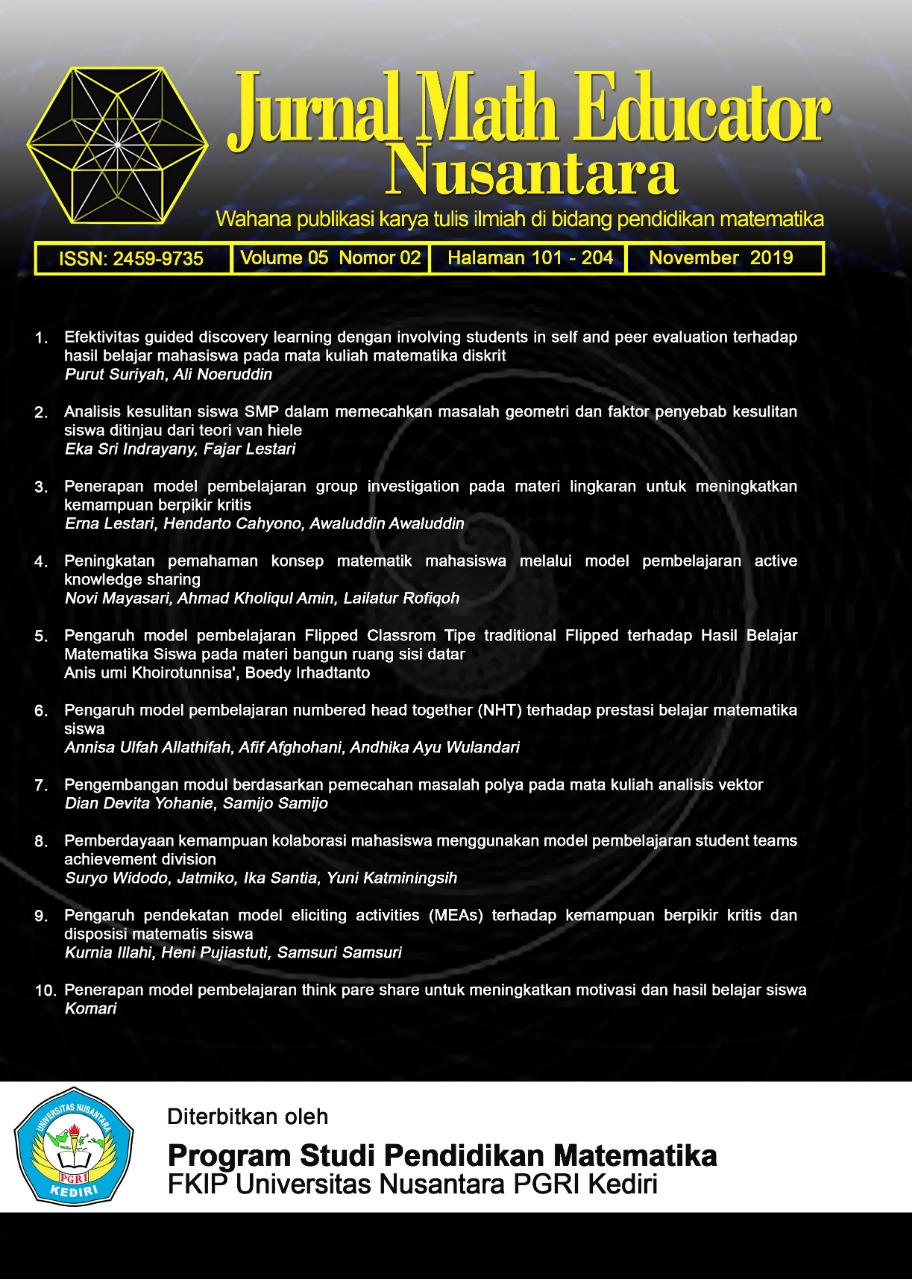Pengaruh model pembelajaran Flipped Classrom Tipe traditional Flipped terhadap Hasil Belajar Matematika Siswa pada materi bangun ruang sisi datar
DOI:
https://doi.org/10.29407/jmen.v5i2.13484Keywords:
flipped classroom, pembelajaran tradisional, prestasi siswaAbstract
Penelitian ini bertujuan untuk mengetahui apakah terdapat perbedaan antara model pembelajaran flipped classroom tipe traditional flipped dan model pembelajaran langsung dengan prestasi belajar siswa pada pembelajaran matematika. Penelitian ini menggunakan desain penelitian quasi eksperimental dengan desain pretest-postest Group. Teknik pengambilan sampel dilakukan dengan stratified cluster random sampling. Instrumen yang digunakan untuk mengukur prestasi belajar siswa adalah tes dengan pilihan ganda. Analisis data yang digunakan kuantitatif dengan uji-t varian yang disurvei menggunakan perangkat lunak SPSS 22. Hasil penelitian ini adalah t-observasi adalah 63,571 lebih tinggi dari t-tabel 1,6694 itu menunjukkan bahwa ada perbedaan dalam hasil prestasi belajar siswa dengan pembelajaran flipped classroom tipe traditional flipped dan pembelajaran langsung. Kelas flipped classroom tipe traditional flipped lebih baik daripada kelas langsung karena siswa lebih mandiri dan lebih siap untuk belajar di kelas.
References
Clark, R. E. (2008). Reconsidering Research on Learning from Media. Review of Educational Research. https://doi.org/10.3102/00346543053004445
Danesi, M. (2007). A conceptual metaphor framework for the teaching of mathematics. Studies in Philosophy and Education. https://doi.org/10.1007/s11217-007-9035-5
DeHaan, R. L. (2011). Teaching creative science thinking. Science. https://doi.org/10.1126/science.1207918
Enfield, J. (2013). Looking at the Impact of the Flipped Classroom Model of Instruction on Undergraduate Multimedia Students at CSUN. TechTrends. https://doi.org/10.1007/s11528-013-0698-1
Hamdan, N., McKnight, P., McKnight, K., & Arfstrom, K. M. (2013). The flipped learning model: A white paper based on the literature review titled a review of flipped learning. Flipped Learning Network. https://doi.org/10.1016/j.compedu.2015.07.008
Hasrul. (2009). Pemahaman Tentang Gaya Belajar. Jurnal Medtek.
Hidayati, N., & Wuryandari, A. I. (2013). Media Design for Learning Indonesian in Junior High School Level. Procedia - Social and Behavioral Sciences. https://doi.org/10.1016/j.sbspro.2012.11.354
Krismanto, A. (2003). Beberapa Teknik, Model, dan Strategi dalam Pembelajaran Matematika. Yogyakarta: Depdiknas Dirjen Pendidikan Dasar Dan Menengah PPPG Matematika.
Perlman, C., Weston, C., & Gisel, E. (2005). A web-based tutorial to enhance student learning of activity analysis. Canadian Journal of Occupational Therapy. https://doi.org/10.1177/000841740507200303
Prama Deswita, A. (2017). Pengaruh persepsi siswa tentang gaya mengajar guru dan minat belajar siswa terhadap hasil belajar akuntansi pada program keahlian akuntansi siswa kelas X di SMKN 1 Sawahlunto. Economica. https://doi.org/10.22202/economica.2013.v2.i1.211
Richards, J. C. (2015). The changing face of language learning: Learning beyond the classroom. RELC Journal. https://doi.org/10.1177/0033688214561621
Roehl, A., Reddy, S. L., & Shannon, G. J. (2013). The Flipped Classroom: An Opportunity To Engage Millennial Students Through Active Learning Strategies. Journal of Family & Consumer Sciences. https://doi.org/10.14307/jfcs105.2.12
Saputra, E. A. (2018). Efektivitas model Flipped Classroom Menggunakan Video Pembelajaran Matematika terhadap Pemahaman Konsep. Desimal : Jurnal Matematika, 173-179.
Sugiyono. (2013). metodologi penelitian kuantitatif kualitatif dan R & D. In Bandung: Alfabeta. https://doi.org/10.1164/rccm.200409-1267OC
Sugiyono. (2016). Skala pengukuran dan instrumen penelitian. Metode Penelitian Kuantitatif, Kualitatif, Dan R&D.
Sugiyono, P. D. (2013). Statistik untuk Penelitian. CV. Alvabeta Bandung. https://doi.org/10.1016/S0969-4765(04)00066-9
Zuraidah, K. M. (2016). Pemanfaatan internet sebagai sumber belajar bagi mahasiswa fakultas ekonomi universitas islam negeri mulana malik ibrahim malang. Jurnal Ekonomi MODERNISASI. https://doi.org/10.21067/jem.v10i2.775
Downloads
Published
Issue
Section
License
Authors who publish with this journal agree to the following terms:
- Copyright on any article is retained by the author(s).
- The author grants the journal, the right of first publication with the work simultaneously licensed under a Creative Commons Attribution License that allows others to share the work with an acknowledgment of the work’s authorship and initial publication in this journal.
- Authors are able to enter into separate, additional contractual arrangements for the non-exclusive distribution of the journal’s published version of the work (e.g., post it to an institutional repository or publish it in a book), with an acknowledgment of its initial publication in this journal.
- Authors are permitted and encouraged to post their work online (e.g., in institutional repositories or on their website) prior to and during the submission process, as it can lead to productive exchanges, as well as earlier and greater citation of published work.
- The article and any associated published material is distributed under the Creative Commons Attribution-ShareAlike 4.0 International License
















